A New Motoryacht for Darth Vader
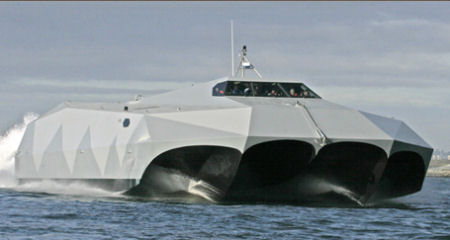 |
|
Luke Skywalker has come down to earth, has made up with his dad, and they are both now cruising happily in the Caribbean, and when things get dull, they catch a drug runner or two. |
You are looking at an experimental vessel that the U.S. military has been testing
for four years. Last month it was put into active duty off Cartagena, Columbia in
drug interdiction exercise with the Columbian Navy. Last fall it caught 3 aliens
that had been
turned to the Dark Side. The origins of this unique hull are bizarre,
nearly every branch of the military has found uses for
it, but in a day of increasing
popularity of power cats, it has some interesting motoryacht possibilities. 88’
x 40’ x 3’, this vessel has 2000-sq.ft. of accommodation space and can travel 50
knots with quad Cats powering Arneson Drives.
 |
|
Picture conventional side decks, a motoryacht house and flying bridge on this platform instead of the helipad and stealthy design. |
What sets the boat apart from other littoral (near shore) military vessels that
we have published on these pages from time to time, is her incredible hull design.
It is called “M-Hull Technology” and it is patented (but you can buy a license).
Here’s what the patent-holder says about the hull: “The M-hull is an advanced, planing-hull
technology providing dominant advantages over legacy designs in terms of ride quality
with speed, stability, range and payload fraction. The reduction of the “drag hump”
offers very efficient cruising speeds not normally associated with planing craft…The
scalability of the design by combining two or more M-hulls side-by-side holds promise
for a new breed of large military craft.”
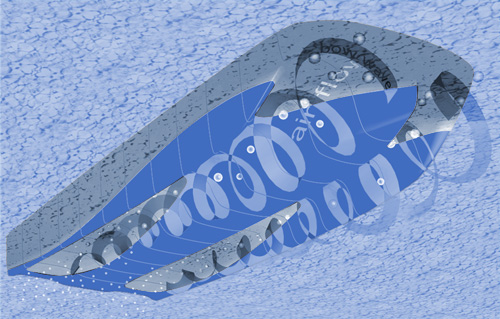 |
|
This drawing is intended to show how compressed air gives lift to the hull at high speed. |
The Navy’s “Stiletto was built by Knight & Carver, a highly respected yacht
building yard in San Diego. It’s prime attribute is the “double M” hull which gives
it five “Vs” – the outer two are called “skirts” and they capture the bow waves
from the three inner deep-V hull shapes and funnel them under the stern as well
as to create stability.
We think it also has some scalable (both down and up) cruising or expedition-type
motoryacht possibilities as well. Picture, for example, a 65’ version with a 30’
beam and a draft of 2-1/2’ pushed by twin 950-hp Yanmar diesels driving through
stern drives. The boat could go virtually anywhere.
According to M Ship Company, the design and development company that holds the patent,
the boat has a “wave piercing front end.” The wave piercing concept has proved itself
in commercial ferry operations all over the world for three decades. At the same
time the hull design reduces drag and pitching. The 88’ Navy “Stilletto” that you
see pictured here has multiple lifting surfaces that are flat to concave in the
after sections of the boat.
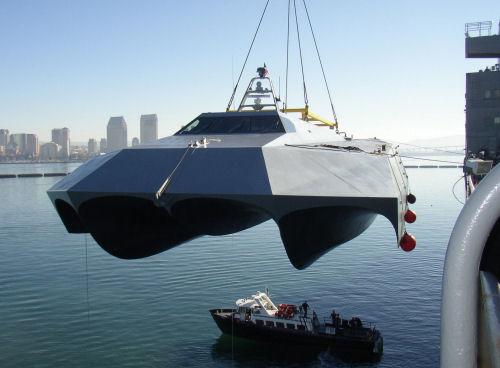 |
|
This view shows the “double M” which funnels the bow wave under the stern. |
A flat or nearly flat bottom aft makes the boat easy to push. As you can see in
the pictures if you look closely the “Stilletto” hull actually has five “Vs” which
provide great stability and rough water shock mitigation at the same time. At high
speed the air captured between the V-hulls and "skirts" give the boat some measure
of lift.
Because the hull is so flat aft its hull drag is reduced and it can carry a load,
yet doesn’t draw much water. The “M-Hull” design also reduces the wake signature,
which was how the whole concept came about it the first place.
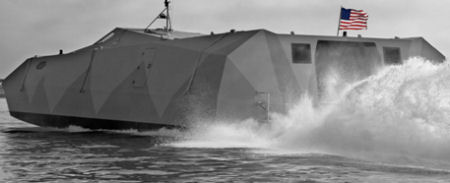 |
|
Note that the port “skirt” does not create much of a wake and the Arneson surface piercing props just makes a harmless rooster tail. |
Beginnings in Venice
The man who dreamed up the design was Charles (Chuck) W. Robinson, who is co-founder
of M Ship Company. Robinson has been involved in ship design for most of his career.
The M-hull evolved from a challenge to help solve the serious problem of wave erosion
to the ancient buildings of Venice, Italy. Since the streets of this city are water,
the authorities were faced with the unique problem of reducing waves created by
motorboats to protect the foundations of the buildings along the canals. Chuck Robinson,
who lives in the USA but has an apartment in Venice, decided that he had to do something.
The result of this effort was the “M-Hull.” This patented hull form exhibits the
shock mitigation features of the deep-V hull with the roll stability of a multihull.
In addition, the hull form creates a natural surface effect that not only enhances
top speed performance, but actually uses the bow wave energy to reduce the overall
wake signature. (The bow wave is “captured” by the outer "skirts" which bounce them
back to be mashed down by the stern.)
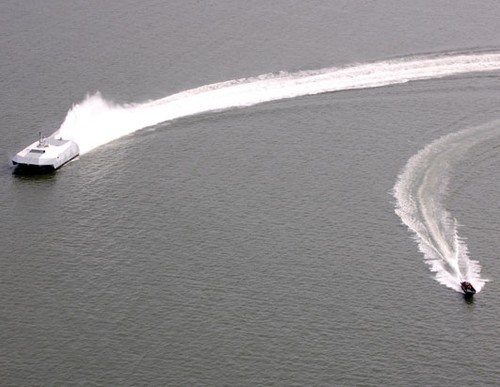 |
|
The US Military is undertaking tests on the high-speed Stiletto Boat which it plans to use to catch drug smugglers. |
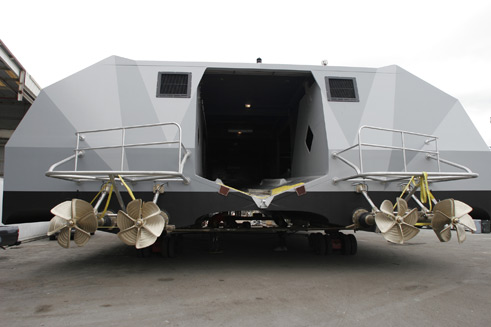 |
|
Stern view out of water showing the Arneson drives. |
The 60-ton (wet) “Stiletto” was built for the Pentagon's Office of Force Transformation
to revolutionize shallow water and riverine operations. It is the first and largest
carbon fiber ship built for the United States military, we’re told. The ship's M-shaped,
light-weight hull make it look like a stealth aircraft and make it ideal for navigating
shallow waters to detect mines and support special ops. Since the ship's launch in January 2005, Stiletto has participated in joint military training off of the
coast of California, South American in the Caribbean and in Florida.
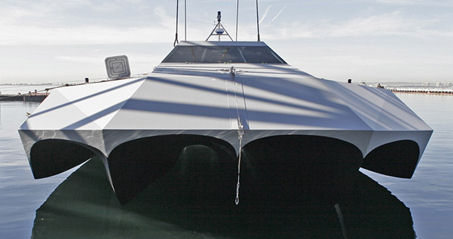 |
| Note the “double M” design and the flat wake. |
She is powered with four Caterpillar C32 1232 kW (1652 HP) yielding a top speed
in excess of 50 knots (90 km/h) and providing a range of 500 nautical miles (900
km) when fully loaded. It can be outfitted with jet drives for shallow water operations
and beaching.
 |
|
Here you see Navy Seals testing the “Stiletto’s” user friendliness. |
It weighs 45 tons unloaded, light enough that it can be hoisted onto a cargo ship,
while still able to carry up to 20 tons of cargo in the 1,996 square feet (200 m2)
of usable interior space. The vessel has a base cost of roughly $6 million, while
a fully equipped boat would be in the $10 million range.
Current M Ship products include water taxis, the EcoBarca environmentally sensitive
tourism ship, and a sport fishing vessel in addition to the Stiletto. Other proposed
variants include cargo, commercial shipping, Coast Guard, and larger military applications
like the MS 120 and MS 200 Littoral.
In the Next Issue of Offshore Motoryacht...
In two weeks we will show you some exciting drawings that M Ship Co. has made for
a pleasure motoryacht. The company CEO Bill Burns, tells us that by building the
hull of E-glass instead of carbon fiber and by scaling it down a bit, its price
tag can drop far below the military version.
Visit M Ship Co. website...